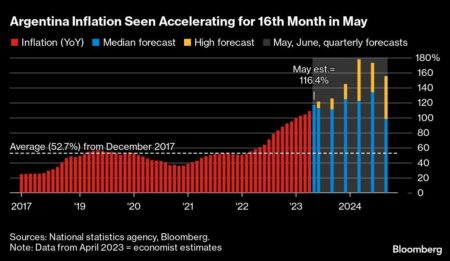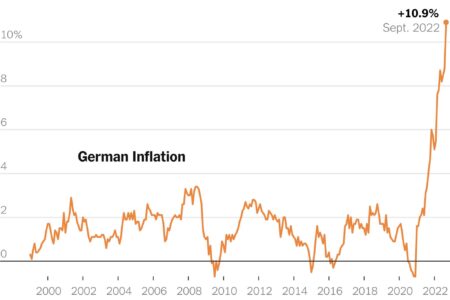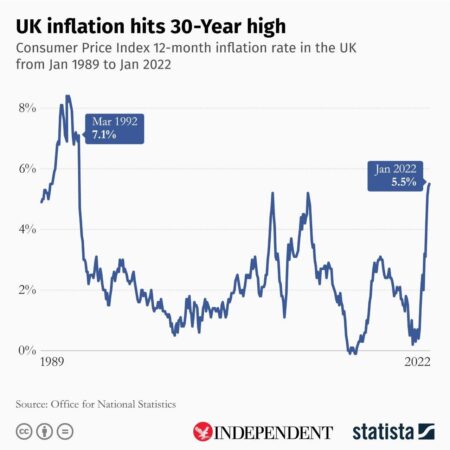Japan is finally shedding its long-standing resistance to price hikes as inflation rises, signaling a powerful shift in both consumer and corporate mindsets. This change marks an exciting new era for Japan’s economy, long defined by the grip of deflation
Browsing: consumer prices
Argentina’s inflation is poised to spike once more in June after a short-lived dip in May, Reuters reports. Skyrocketing prices continue to squeeze the economy, fueled by currency instability and unyielding consumer demand
Argentina’s inflation inched up slightly in April, rising less than market expectations, Bloomberg reports. This modest rise offers a promising sign of stability amid the country’s ongoing economic challenges
Inflation skyrocketed to its highest level since January 2024 in June, ramping up the pressure on consumer prices. Experts warn that this sharp rise could significantly shape upcoming monetary policy decisions
Chinese President Xi Jinping is signaling a bold new strategy to put an end to the prolonged deflationary price wars, with the goal of stabilizing markets and sparking robust economic growth, Yahoo Finance reports. This move has the potential to reshape China’s competitive landscape in a profound way
Retailers who embraced Made in the USA products quickly found that higher prices posed a challenge for their customers, Reuters reports. Although the shift aimed to boost local manufacturing, it faced an uphill battle winning over shoppers watching their wallets
US prices for China-made goods on Amazon are soaring faster than inflation, a recent analysis reveals. Tariffs and supply chain challenges are pushing costs higher, directly impacting consumers’ wallets, Reuters reports
Inflation in France and Spain edged higher for the first time in 2025, signaling new hurdles for eurozone policymakers. Surging prices in key sectors are beginning to rattle consumer confidence, the WSJ reports
Germany’s inflation rate held firm at 2.1% in May, reflecting steady consumer prices amid ongoing economic challenges. This encouraging data sparks cautious optimism for Europe’s largest economy. (NYSEARCA:EWG)
UK inflation rates have skyrocketed, sparking worries about the rising cost of living. Recent data reveals that prices are climbing at an alarming rate, affecting everything from your weekly grocery shop to soaring energy bills. As families prepare for tighter budgets, experts are weighing in on the potential economic fallout.
In April, German inflation dipped to 2.2%, just shy of what analysts had anticipated. This decrease offers a glimmer of hope in easing price pressures, yet it also underscores the ongoing hurdles facing the economy as policymakers strive to steer recovery through a landscape marked by persistent volatility.
In a surprising turn of events, India’s inflation rate plummeted to an impressive 3.34% in March, far surpassing analysts’ predictions. This notable drop could potentially reshape economic policies as decision-makers evaluate its effects on consumer spending and overall growth.
Inflation in Canada eased to 2.3% in March, largely due to a decline in gas prices, according to recent data. This marks a slight improvement, offering some relief to consumers as the cost of living remains a key concern nationwide.
In a recent escalation of trade tensions, Trump’s proposed tariffs on Chinese goods are set to significantly impact ‘Main Street’ U.S. businesses that rely on Amazon. Experts warn that increased costs could crush small retailers struggling to compete.
U.K. inflation fell to 2.8% in February, offering a temporary reprieve for consumers and policymakers. However, analysts warn that factors such as rising energy costs and supply chain disruptions could drive prices up again shortly.
In response to U.S. tariffs imposed by the Trump administration, Canadians are strategizing innovative solutions to mitigate economic impacts. From diversifying trade partnerships to advocating local production, these efforts reflect a resilient spirit in the face of protectionism.
Starting Tuesday, Trump’s tariffs on imports from Canada and Mexico will take effect, affecting a range of goods. Consumers could see rising prices on products such as steel, aluminum, and certain food items as costs increase along the supply chain.
Australia’s Consumer Price Index (CPI) inflation held steady at 2.5% year-on-year in January, slightly below the expected 2.6%. This stability suggests a controlled inflation environment, providing insight into the nation’s economic health moving forward.
Argentina’s monthly inflation rate slowed in January to its lowest level in over four years, providing a glimmer of hope for an economy plagued by soaring prices. Analysts view this development as a potential turning point amid ongoing economic challenges.


















